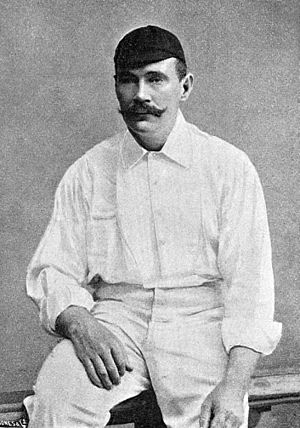Jim Phillips (cricketer) facts for kids

Jim Phillips
|
|||||||||||||||||||||||||||
| Personal information | |||||||||||||||||||||||||||
|---|---|---|---|---|---|---|---|---|---|---|---|---|---|---|---|---|---|---|---|---|---|---|---|---|---|---|---|
| Full name |
James Phillips
|
||||||||||||||||||||||||||
| Born | 1 September 1860 Pleasant Creek, Victoria, Australia |
||||||||||||||||||||||||||
| Died | 21 April 1930 (aged 69) Burnaby, British Columbia, Canada |
||||||||||||||||||||||||||
| Batting | Right-handed | ||||||||||||||||||||||||||
| Bowling | Right arm medium | ||||||||||||||||||||||||||
| Role | Umpire | ||||||||||||||||||||||||||
| Domestic team information | |||||||||||||||||||||||||||
| Years | Team | ||||||||||||||||||||||||||
| 1885–1896 | Victoria | ||||||||||||||||||||||||||
| 1890–1898 | Middlesex | ||||||||||||||||||||||||||
| 1898–1899 | Canterbury | ||||||||||||||||||||||||||
| Umpiring information | |||||||||||||||||||||||||||
| Tests umpired | 29 (1885–1906) | ||||||||||||||||||||||||||
| Career statistics | |||||||||||||||||||||||||||
|
|||||||||||||||||||||||||||
|
Source: CricketArchive, 8 September 2009
|
|||||||||||||||||||||||||||
James Phillips (born September 1, 1860, in Pleasant Creek, Australia – died April 21, 1930, in Burnaby, Canada) was a famous Australian cricketer and a very important Test match umpire. He played top-level cricket for teams like Victoria, Middlesex, and Canterbury. Later, he became known as one of the first truly "international" cricket umpires, travelling around the world to officiate Test matches.
Contents
Who Was Jim Phillips?
James Phillips, often called 'Dimboola Jim', was a talented sportsman. He was known for his fairness and strong decisions as an umpire. He played a big part in making cricket a fairer game, especially by stopping players from throwing the ball instead of bowling it properly.
A Talented Cricketer
Phillips did not play his first important cricket match until 1885. He played 124 matches for Canterbury, Middlesex, and Victoria between 1885 and 1899. He was a right-handed batsman and a right-arm medium-pace bowler.
He scored 1,827 runs in his career, with his highest score being 110 runs without being out. As a bowler, he took 355 wickets, which means he got 355 batsmen out. His best bowling performance was taking 8 wickets while only giving away 69 runs. Seven times in a match, he took 10 or more wickets, which is a great achievement for a bowler. He also caught 50 balls as a fielder.
Phillips travelled a lot between Australia and England, playing and umpiring cricket. The Middlesex team thought he was so valuable that they held a special "benefit match" for him in 1899. This was a game played to raise money for him. He also helped other Australian players find jobs and play cricket in England. For a while, he coached in Christchurch, New Zealand, and played for the Canterbury team there.
An International Umpire
Jim Phillips umpired a total of 29 Test matches. His first Test match was between Australia and England in Melbourne in March 1885. England won that game easily.
He umpired 13 Test matches in Australia, including all 5 games in the 1894-95 and 1897-98 series against England. He also umpired 11 matches in England when Australian teams visited. This included all 3 games in 1896 and 4 out of 5 games in 1905. His last matches were the 5 games played in South Africa against England in 1905-06. Because he umpired in so many different countries, he is considered the first truly "international" Test umpire.
Standing Up for Fair Play
Jim Phillips was known as a very brave umpire. He was largely responsible for stopping players from "throwing" the ball around the year 1900. Throwing means a bowler straightens their arm during the delivery, which is against the rules. Phillips was famous for his skill and honesty.
He even called out famous Australian Test players like Ernie Jones and Tom McKibbin for throwing. Ernie Jones was first called for throwing in a match in 1897. Phillips called him again in a Test match, making Jones the first bowler to be called for throwing in a Test match. Because of Phillips' strictness, another player, Jack Saunders, was not chosen for the 1905 team to tour England. People worried that Phillips would call him for throwing.
Some people blamed English umpires for the problem, saying they allowed throwing too much. Phillips' actions, including calling out the English amateur champion C. B. Fry, led to a meeting of cricket captains in 1900. They decided that some regular bowlers should not be used the next season because of their throwing actions.
Tricky Moments on the Field
In the first Test match of 1897-98, Phillips gave a player named Charlie McLeod "run out." McLeod was bowled by a no-ball, but because he was deaf, he did not hear the umpire's call. He thought he was out and left the wicket. A fielder then pulled out a stump and appealed. Today, McLeod would be given "not out" because he left the wicket by mistake, thinking he was out.
Another time, during the 4th Test of the 1897-98 series in Melbourne, smoke from bushfires made it hard to see. The English captain said play should stop because of bad light. Umpire Phillips disagreed, saying that if that light was bad, then cricket should stop entirely in some English stadiums. An English player jokingly said that Australia was the only place where the country was set on fire just to win a cricket match!
Life After Cricket
After he retired from cricket, Jim Phillips became a mining engineer. It is said that he became very rich in North America.
See also
- List of Test cricket umpires
- List of Victoria first-class cricketers

